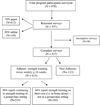Strength training and older women: a cross-sectional study examining factors related to exercise adherence
- PMID: 20440031
- PMCID: PMC4308058
- DOI: 10.1123/japa.18.2.201
Strength training and older women: a cross-sectional study examining factors related to exercise adherence
Abstract
Background: Despite the recognized health benefits, few older women participate in strength-training exercises.
Methods: The purpose of this study was to examine factors related to older women's adherence to strength training after participation in the StrongWomen Program, a nationally disseminated community program. Adherence was defined as > or =4 months of twice-weekly strength training. Surveys were sent to 970 program participants from 23 states and to participants' corresponding program leaders. Five-hundred fifty-seven participants responded (57%).
Results: Of respondents who completed surveys (527), 79% (415) adhered to strength training; adherers reported a mean of 14.1 +/- 9.1 months of strength training. Logistic-regression analysis revealed that exercise adherence was positively associated with age (p = .001), higher lifetime physical activity levels (p = .045), better perceived health (p = .003), leader's sports participation (p = .028), and leader's prior experience leading programs (p = .006).
Conclusion: These data lend insight to factors that may be related to exercise adherence among midlife and older women.
Figures


References
-
- American College of Sports Medicine. ACSM position stand on osteoporosis and exercise. Medicine and Science in Sports and Exercise. 27(4):i–vii. - PubMed
-
- American College of Sports Medicine. American College of Sports Medicine position stand. The recommended quantity and quality of exercise for developing and maintaining cardiorespiratory and muscular fitness, and flexibility in healthy adults. Medicine and Science in Sports and Exercise. 1998;30(6):975–991. - PubMed
-
- Australian Electoral Commission. The official 2004 federal election results. 2004 Retrieved from http://results.aec.gov.au/12246/results/default.htm.
-
- Baker KR, Nelson ME, Felson DT, Layne JE, Sarno R, Roubenoff R. The efficacy of home based progressive strength training in older adults with knee osteoarthritis: A randomized controlled trial. The Journal of Rheumatology. 2001;28(7):1655–1665. - PubMed
MeSH terms
Grants and funding
LinkOut - more resources
Full Text Sources

